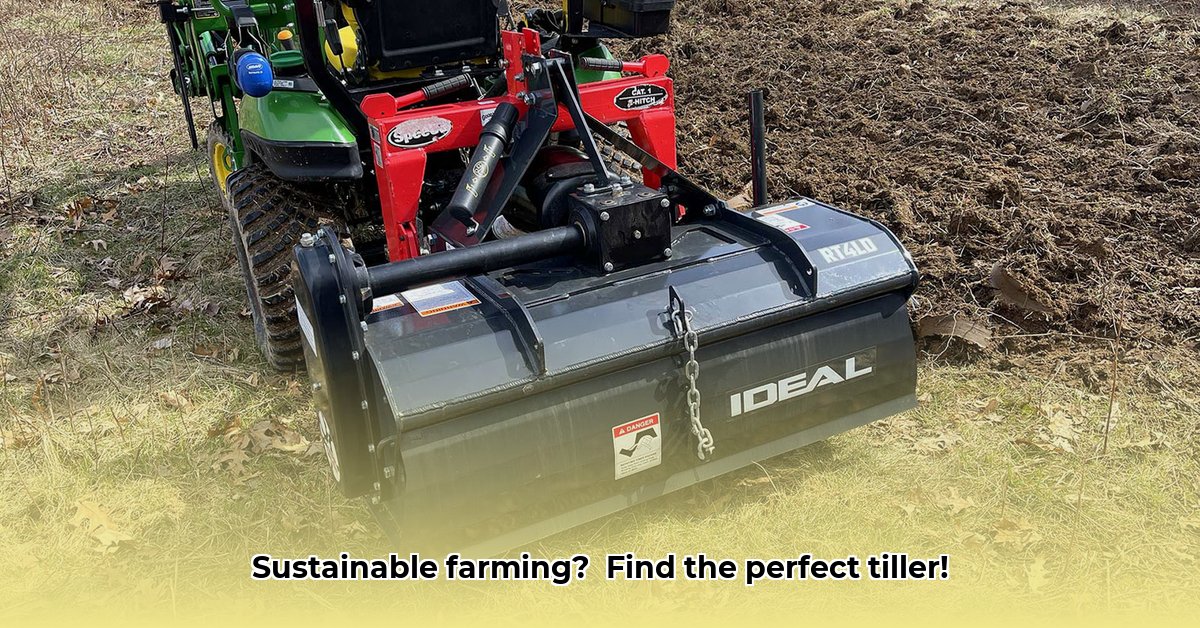
Ready to enhance your small farm's productivity? Selecting the right tiller for your compact tractor is a crucial step towards sustainable and efficient soil preparation. This guide provides a step-by-step approach to finding the perfect tiller, ensuring optimal soil health and minimizing environmental impact. For more information on compact tractor tillers, see this helpful resource.
Key Factors in Choosing Your Compact Tractor Tiller
Picking the right tiller is like choosing the right tool for a specific job; the wrong one makes the job harder and may even cause damage. Let's explore the key factors to consider:
Tiller Width: Finding the Sweet Spot
The tiller's width significantly impacts efficiency. Too narrow, and you'll spend more time tilling. Too wide, and you risk overloading your tractor, potentially causing damage. Consult your tractor's manual for recommended tiller width based on its horsepower. A good rule of thumb is to choose a width that allows for comfortable maneuverability without excessive strain on your tractor. What is the ideal tiller width for your tractor and land size?
Drive Mechanism: Gear vs. Chain
Two primary drive mechanisms exist: gear and chain. Gear drives generally offer superior power and durability, making them ideal for heavy soils. However, they tend to be more expensive and require more specialized maintenance. Chain drives, simpler and more affordable, are suitable for lighter soils and budgets, offering easier maintenance. Which drive mechanism best suits your soil conditions and budget?
Tiller Weight: Balancing Power and Soil Compaction
Heavier tillers excel at breaking up compacted, heavy clay soils. However, lighter tillers are gentler on your tractor and reduce the risk of further soil compaction. The optimal weight depends on your soil type. For lighter soils, a lighter tiller minimizes soil disturbance. For heavier soils, a heavier tiller is necessary for effective tilling. What weight tiller best addresses your specific soil conditions?
Rotation: Forward vs. Reverse
Most tillers offer both forward and reverse rotation. Forward rotation effectively buries crop residue, benefiting soil health. Reverse rotation proves more aggressive, suitable for breaking up heavily compacted soils. How will the choice of rotation impact your soil preparation goals?
RPM (Revolutions Per Minute): Optimizing Tilling Speed
Higher RPMs generally translate to faster and more thorough tilling. However, always check your tractor's Power Take-Off (PTO) specifications for compatibility. Using a tiller at an unsuitable RPM can damage both your tractor and the tiller itself. What RPM is best suited for your tiller and tractor combination?
Tine Count: The Impact of Digging Parts
The number of tines affects tilling efficiency. While more tines generally lead to finer tilling, they also increase power demands. A six-tine tiller is often a good balance between performance and power consumption. How many tines provide the ideal balance of thoroughness and tractor capability for your needs?
PTO Safety: Protecting Your Investment and Yourself
Never overlook PTO safety. Your tiller should have a shear bolt or slip clutch to safeguard your tractor's drivetrain from damage if you hit an obstruction. Always ensure the safety mechanisms are functioning properly before operation. What safety features are paramount for safe and efficient tilling?
Matching Tiller to Tractor: Avoiding Overloading
Proper matching is critical to avoid mechanical issues. Your tractor's owner's manual will specify the recommended tiller size and horsepower compatibility. Ignoring these recommendations may lead to serious damage. Always match tiller size and horsepower capacity to your tractor’s capabilities. How do you ensure your chosen compact tractor and tiller share harmonious functionality?
Soil Type Considerations: Adapting to Your Land
Soil type significantly impacts tiller choice. Consider having your soil tested to determine its composition using local agricultural extension services.
- Light, Sandy Soils: Require lighter tillers with fewer tines and a less aggressive design.
- Clay, Heavy Soils: Benefit from heavier tillers, more tines, and a more aggressive design.
- Rocky Soils: Need robust designs with strong safety mechanisms and potentially wider tines to prevent damage.
How does your soil type influence your tiller selection criteria?
Sustainable Practices: Tilling for the Future
Sustainable farming prioritizes minimizing soil disturbance. Over-tilling compacts the soil, reducing water infiltration and harming soil structure. Consider no-till or reduced-till methods whenever possible. How does your choice of tiller contribute to environmentally friendly farming practices?
Safety Precautions: Operating Your Equipment Responsibly
Safe operation is paramount. Always wear protective gear (boots, gloves, eye protection), engage PTO safety mechanisms before starting, receive proper training, and be aware of your surroundings. What safety measures will you prioritize when operating your compact tractor with a tiller?
Maintenance and Repair: Extending Tiller Lifespan
Regular maintenance is vital for your tiller's longevity. This includes lubricating moving parts, regularly sharpening tines, and inspecting for wear and tear. Be aware of when to seek professional repair. How will you maintain your tiller for optimal performance and service life?
Conclusion: Making an Informed Choice
Selecting the right tiller for your compact tractor is an investment that significantly impacts your farm's efficiency, soil health, and overall sustainability. By carefully considering the factors outlined in this guide, you can make an informed choice that benefits your crops and the environment. What strategies for selecting a tiller and maintaining a healthy farming ecosystem are you committed to?
Resources
- Your local agricultural extension service
- National Sustainable Agriculture Information Service (SAIS)
- Manufacturer websites for tractors and tillers